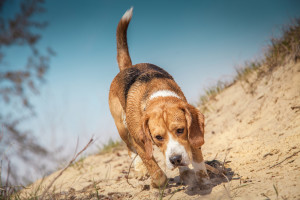
A landscape of odors….
Compared to canines, humans smell in black and white. We live in a world of sight and sound, words and letters. If you wrote a novel for dogs, you’d have to use smells – it would be a scratch-and-sniff book. Dogs find their literature on the ground, on trees, and under bushes; a stroll in the woods is to browse through a library. They “see” the world as an aromatic landscape colored with scents we can’t even imagine.

It’s precisely that facility that makes dogs so useful to law enforcement. Their olfactory perception complements a detective’s visual perception and can offer critical clues in a criminal investigation.
Cadaver dogs begin their careers

Systematic training for cadaver dogs began in the 1970s. Modern human remains detection dogs learn to distinguish the odors of human decomposition from those of animal decomposition and track them through varied terrains. But that doesn’t mean that no one ever used dogs for finding dead bodies before the 1970s. One of the first recorded instances of a court purposely using a dog to search for a murder victim occurred during the investigation of the Bavarian Ripper in 1809.
Hanns Gross, an Austrian criminologist and the father of modern forensic science, wrote about the need for cadaver dog searches as early as 1899:

“Undertaking outdoor [searches] is difficult under any circumstances. Systematic searching is almost always impossible due to the size of the territory; success is due to chance. Only in one circumstance is outside assistance advisable: searching for a human body. For that purpose, a good tracking dog can be used. Not every bloodhound or Leithund [a 19th c. German breed similar to the Weimaraner] can be used, however; only a few dogs possess the right facilities for the task. But if the investigating magistrate needs help in such a case, it won’t suffice if he just orders: “Get me a tracking dog.” He most certainly won’t obtain any help in this manner. He must, as discussed above, prepare for war during peacetime. This is all the more necessary because you often find such dogs in completely unexpected places, and can’t find one on the spot when you need one.”
A watchdog breaks the case
Gross managed to find a good dog and described how it found a body quickly enough to exculpate the suspect:

“A tanner in my district had a garden-variety watchdog that didn’t have a bit of hunting dog in him, but (I think it merely due to his voraciousness) could find every single piece of carrion within a huge perimeter. For that reason, the local hunters borrowed him to find all the game they shot that their hunting dogs couldn’t find. The tanner’s dog found everything that was animal and dead. He would come to a standstill for wounded deer as well as a long-dead cat, but he found both. Once, when we needed to search for a missing cretin, presumed to have been murdered by his brother-in-law, this dog found the cretin’s body deep in the woods. At that point it was still possible to determine that the cretin had died as a result of an epileptic seizure, but a few days later, it might not have been possible to make a postmortem finding that no violence had occurred, and the suspicion would have followed the brother-in-law for the rest of his life.”

The dogs in this case and the Bavarian Ripper investigation proved their worth. One discovered the bodies, providing the crucial piece of evidence to convict a murderer, and the other found the body quickly for investigators to prove there was no murder, and exonerated an innocent suspect. Hats off to cadaver dogs and their forerunners in the 19th century!
What are some of the unusual things your dog has found with its nose?
Literature on point:
Hanns Gross, Handbuch für Untersuchungsrichter (3rd ed., Graz: Leuschner & Lubensky’s 1899) pp. 122-124 (translation mine).
Cat Warren, What the Dog Knows (New York: Touchstone 2013)




More details on the Bavarian Ripper please!
Click on “Bavarian Ripper.” It’s a link. It should take you to my post about the Ripper. In short, he murdered two girls around 1809 and buried their bodies in his yard. When a court-ordered search of the Ripper’s premises proved fruitless, a court official brought his dog, who alerted at a spot behind the Ripper’s shed. That convinced the court to order a renewed search, and the girls were found buried where the dog indicated. The Ripper was convicted and executed the same year.
My nose wrinkles as I avoid the scent. My Labradors sniff out and eat anything in ice, mud, snow, earth, or water. They find the tiniest shards of deer bone from a site where a deer was shot two seasons ago. My most talented scavenger learned to open picnic coolers at the campsites half a mile from home. He’d slip away and return with a neatly packaged pound of bacon or hot dogs. We put an end to his wandering and thievery after paying off a few irate campers. Impressive noses, those dogs.
Elaine, that is hilarious that your dog learned to locate and open picnic coolers! How were you able to stop it?
Yes, those dogs have impressive noses.
[…] an eye on turkey vulture kettles during her searches. But other wild birds offer clues, too. Hanns Gross, the Austrian father of criminology, kept his eye on European vultures and kites, but also on a different carrion-eating genus: the […]
[…] have used human remains detection dogs since the 19th century, but only during the 1970s has law enforcement standardized training. Different countries have […]